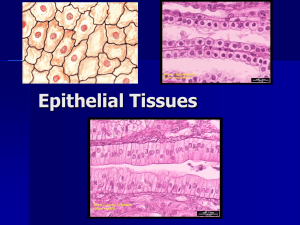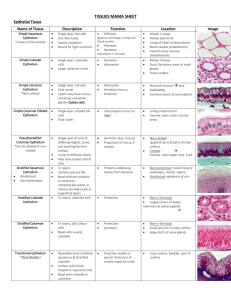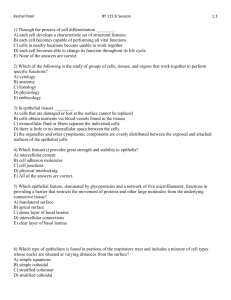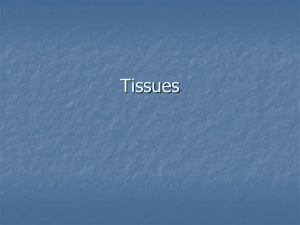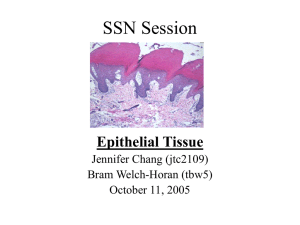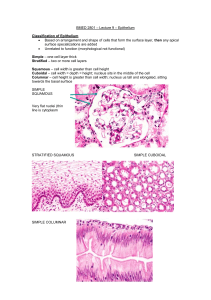Body Tissues
advertisement
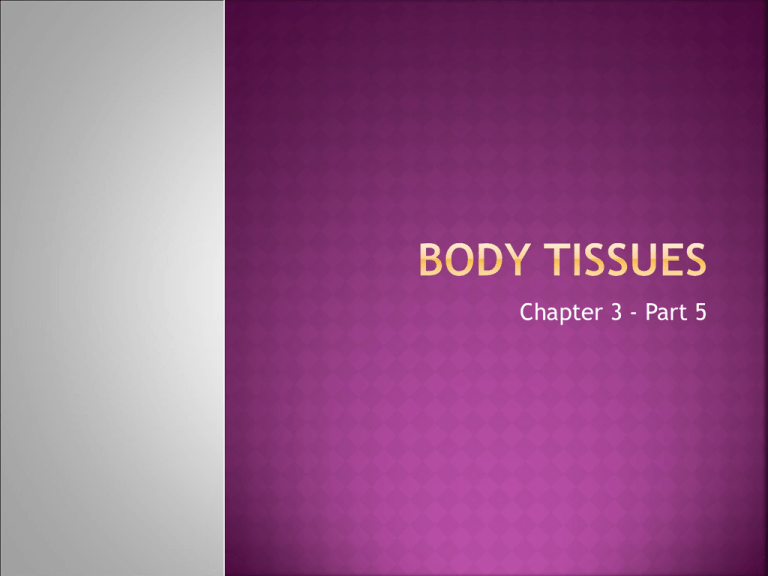
Chapter 3 - Part 5 Tissues – Groups of cells that are similar in structure and function. There are four primary tissue types: 1. 2. 3. 4. Epithelial (covering) Connective tissue (support) Nervous tissue (control) Muscle (movement) Tissues are organized into organs and the arrangement of the tissues determines each organ’s structure and what it is able to do. Epithelial Tissue (Epithelium) – The lining, covering, and glandular tissue of the body. Glandular epithelium forms various glands in the body. Covering and lining epithelium covers all free body surfaces and contains versatile cells. One cell type covers the outer layer of the skin. Others dip into the body to line its cavities. 1. Protection 2. Absorption 3. Example: Epithelium that lines the stomach and small intestine. Filtration 4. Example: Skin Example: Epithelium that lines the kidneys. Secretion Example: Glands found in the skin such as sweat and oil glands. 1. Epithelial cells fit closely together to form continuous sheets. 2. Bound together by cell junctions including desmosomes and tight junctions. The membranes always have one free unattached surface or edge. This so-called apical surface is exposed to the body’s exterior or to the cavity of an internal organ. 3. 4. The lower surface rests on a basement membrane, a structureless material secreted by the cells. Have no blood supply of their own. 5. They are avascular and depend on diffusion from the capillaries in the underlying connective tissue for food and oxygen. If well nourished, epithelial cells regenerate themselves easily. Each 1. First Name: Indicates the relative number of layers it has. 2. epithelium is given two names. Simple Epithelium – Epithelium that contains one layer of cells. Stratified Epithelium – Epithelium that contains more than one cell layer. Second Name: Describes the shape of its cells. Squamous Cells – Flattened like fish scales. Cuboidal Cells – Cube-shaped like dice. Columnar Cells – Shaped like columns. Simple Squamous Epithelium –Single layer of thin squamous cells resting on a basement layer. Cells fit closely together, much like floor tiles. Usually forms membranes where filtration or exchange of substances by rapid diffusion occurs. Also forms the serous membranes, or serosae, the slick membranes that line the ventral body cavity and cover the organs in that cavity. Example: Air sacs of lungs Simple Cuboidal Epithelium – One layer of cuboidal cells resting on a basement membrane. Common in glands and in their ducts. Forms the walls of the kidney tubules. Covers the surface of the ovaries. Simple Columnar Epithelium – Made up of a single layer of tall cells that fit closely together. Lines the entire length of the digestive tract from the stomach to the anus. Includes: Mucosae (Mucus Membranes) – Epithelial membranes that line body cavities open to the body exterior. Goblet Cells – Produce a lubricating mucus. Pseudostratified Columnar Epithleium – All of the cells rest on a basement membrane; Some of its cells are shorter than others and their nuclei appear at different heights above the basement membrane. This epithelium gives the false (pseudo) impression that it is stratified. Mainly functions in absorption and secretion. A ciliated form lines the respiratory tract and propels the mucus upward and away from the lungs. Stratified Squamous Epithelium – Consists of several layers; cells at the free edge are squamous whereas those close to the basement membrane are cuboidal or columnar. Most common stratified epithelium in the body. Found in sites that receive a good deal of abuse or friction, such as the esophagus, the mouth, or the outer portion of the skin. Statified Cuboidal Epithelium – Usually has just two cell layers with (at least) the surface cells being cuboidal in shape. Fairly rare in the body. Found mainly in the ducts of large glands. Stratified Columnar Epithelium – At least two cell layers; the surface cells are columnar in shape, but its basal cells vary in size and shape. Fairly rare in the body. Found mainly in the ducts of large glands. Transitional Epithelium – Highly modified, stratified squamous epithelium that forms the lining of only a few organs – the urinary bladder, the ureters, and part of the urethra. All of the organs are part of the urinary system and are subject to considerable stretching. The ability of transitional cells to slide past one another and change their shape allows the bladder, ureters, and urethra to stretch. When the organ is not stretched: Membrane is many- layered and the superficial cells are rounded and domelike. When the organ is stretched: The epithelium thins and the surface cells flatten and become squamouslike. Gland – Consists of one or more cells that make and secrete a particular product. Secretion – Product secreted by a gland Typically contains protein molecules in an aqueous fluid. Secretion is an active process, in which glandular cells obtain needed materials from the blood and use them to make their secretion, which they then discharge. Endocrine Glands – Do not contain ducts; their secretions diffuse directly into the blood vessels that weave through the glands. 1. 2. Examples: Thyroid, adrenal, and pituitary glands. Exocrine Glands – Do contain ducts; secretions empty through ducts to the epithelial surface. Are found both internally and externally. Examples: Sweat and oil glands, liver, and pancreas.



